SEE! Many Tone control circuits. They are the important circuits for controlling the bass and treble effects of the audio system.
We have lists of the top 7 tone control circuits using low noise transistors as main. Although they are relatively old circuits. But I like them. Why?
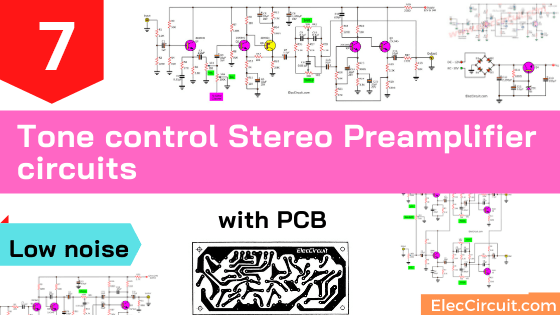
I like its tone, soft and gentle. It’s hard to describe it for you get it. Until you start building it yourself.
Also, you will not have a headache about where to get parts. Because All Other components, you can buy them easily in most of the local electronic stores.
And, easy to builds with PCB layouts. You should not waste time
See all 7 projects below.
Note:
- The amount of transistors affects the strength and quality of the audio signal. Sure, the circuit using 5 transistors is better than 2 transistors.
- If you want to build the best HIGH-QUALITY pre-tone control circuit. See Circuit #7
- However, if you are a beginner. You might try to build a circuit that uses 2 or 3 transistors first. They’re easier.
.
Tone control circuit diagram using 2 transistors
This is a tone control circuit, the small-sized. It is the Mono using 2 transistors. They are important equipment to increase a sound signal, more power-up.
And, we can adjust the sound with a potentiometer, VR1, VR2, and VR3. To set a complete sound signal. Or a great treble and bass, too.
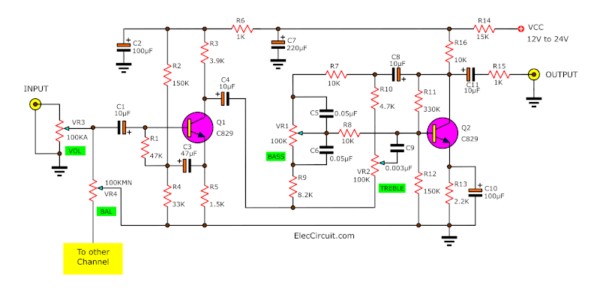
In the circuit. It is convenient for a beginner who wants to try to build a Pre Tone control circuit to keep be usable.
The prominent point of this circuit, easy to buy the components. Even removing good devices from old circuit boards. It works fine, as well. No problem.
For example, transistors C829. You may use the number C945 or C1815 or The other all right.
For the level of power supply. We can use a wide range of about 12V to 24V at 3mA only.
See other detail in the circuit.
PCB layout
Components layout
The PCB layout and components layout of Classic Tone Control using 2 Transistors C945
In this circuit, it is a mono system. But if you want a stereo system. Usually, we just do one more set. But we look at this second circuit better. It’s a dedicated stereo system.
.
Stereo Tone Control using 2 transistors
See in the circuit below.
In addition to adding another circuit. Each circuit has a resistor and capacitor (C2 and R3) added to better compensate for the audio frequency. C8 can reduce the high-frequency noise well.
For the power supply.
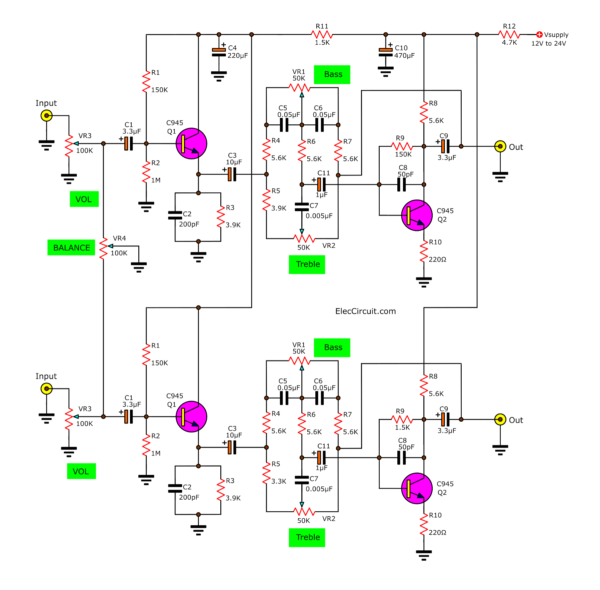
The Circuit of Tone Control Stereo using C945x2 Transistors
This circuit should use a 12V to 24V power supply. See R12, we know that ะhis circuit uses very little current, about less than 4 mA.
You may be able to use x2 9V batteries, with connecting the series, it works fine.
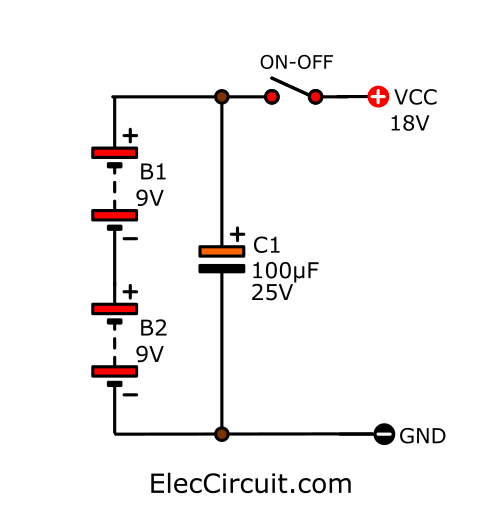
Then, build the circuit.
PCB lay out Tone Control Stereo using C945x2 Transistor
Components layout of Stereo pre tone control using 2 transistors
Headphone Bass-Treble control circuit with PCB
If you want to adjust the tone of audio in low voltage states for a HEADPHONE. Is it impossible? Most tone control circuit requires a 12V power supply. This circuit can do.
How it works
To begin with, this circuit will connect the switch-S1, to apply the power supply to the circuit and the input has an audio signal source.
Function of each devices
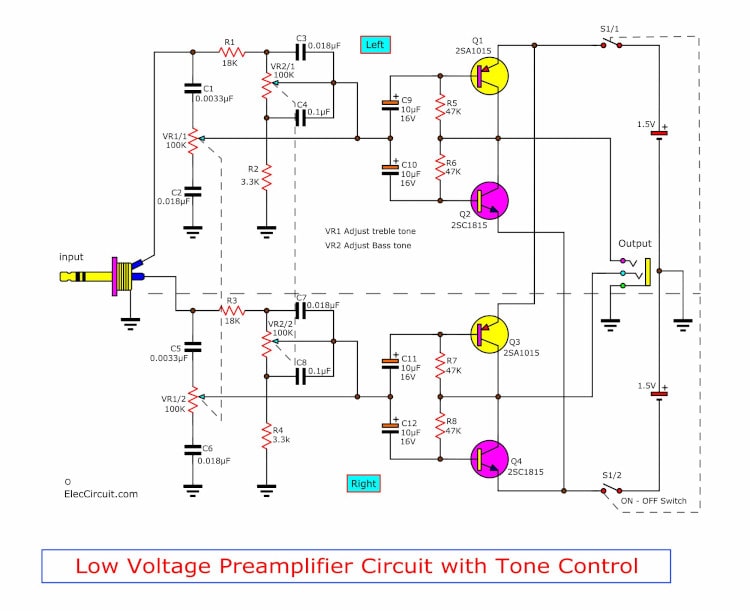
1. There are C1, C2, and VR1/1 are set the input audio signal to high frequency up. The VR1/1 adjusts the treble for the left headphone.
2. The similar a right way, the C5, C6 and VR1/2 are set the input audio signal to high frequency up. We adjust the VR1/2 adjusts to control the treble for headphone channel right.
3. When we want stereo sound. So, controlling the treble of the left headphone is equal to the treble of the right headphone.
So we use the VR1 is Dual Audio Potentiometer. Because changes in the resistance of VR1/1 are equal to the resistance of VR1/2.
And must use C1 is equal C5, C2 is equal C6.
If you do not like tone of that treble sound. It can be modified circuit. By changing the value of C1, C2, C5, C6 and VR1.
But remember, the value of C1 is equal to C5, and C2 is equal to the value of C6.
Here are a few related articles you may want to read:
4. Adjusting the bass, the VR2 is a dual audio potentiometer. Adjusts the audio signal to a lower frequency, both the left and right channel.
There are R1, R2, C3 and C4 determine the bass for the left headphone, And R3, R4, C7, C8 determine the bass in right.
5. To change the devices (C9, C10, C11, and C12) will change the sound frequency left and right, too.
Then, the signals through the bass-treble adjustment circuit, into transistors Q1, Q2, Q3 and Q4. The incoming signal is both positive and negative.
When added to the positive half cycle through C10 to C12 in the previous. The Q2 and Q4 will be amplified of the positive half cycle.
On the other hand, the negative half is through C9 to C11 to Q1 and Q3. They amplify a signal of the negative half cycle.
It has audio headphone output with both the positive and negative half. As the only one input audio signal changes.
Next step build the circuit.
Look
the PCB layout
the components layout
Related: Low noise pre tone control circuit using 4558 – NE5532
The components list
0.25 W, +-5% Resistors R1, R3: 18K (brown, gray, orange, gold) R2, R4: 3.3K (orange, orange, red, gold) R5, R6, R7, R8: 47K (yellow, purple, orange, gold)
Dual-layer potentiometers VR1, VR2: 100K type A
Electrolytic capacitors C9, C10, C11, C12_10uF/ 16V
50V, ceramic capacitors C1, C5: 0.0033uF (332) C2, C3, C6, C7: 0.018uF (183) C4, C8: 0.1uF (104)
Transistors Q1, Q3: 2SA1015 Q2, Q4: 2SC1815 S1: SPST Slider Switch Others
This circuit is suitable for a headphone. If you want high quality sound read below
Active tone control circuit using the transistors
If you want a simple tone control circuit that easy to builds, all components are assembled on one PCB. See this project it may your choice, small size and cheap.
Look at the circuit below.
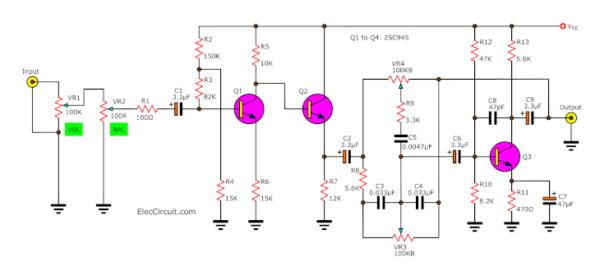
Simple tone control circuit diagram
I like the transistor preamplifiers with tone controls. Because of low noise and classic not outdated.
The tone controls, this is not acceptable. Due to high-quality audio professionals not to use it. Connect popular Audio directly without a sound barrier.
But this system is the most important parameter is the speaker. Your speakers must be highly sensitive, and can resonate with all audio frequencies range.
But in fact, it is very difficult. To find speakers that feature.
Alternative, use tone control to a solution of this speaker. It will increase the treble and boost bass.
There is 2 sections, the power supply, and the tone controls.
First, see the power supply, which has diodes D1-D4 are connected as a bridge rectifier. We so can apply power to all types of AC/DC.
Then, the capacitor-C12 serves to filter the voltage. Next, will into the voltage control circuit, by having Q4, ZD1, R14, C11 serves to maintain constant voltage as 9V DC Regulator.
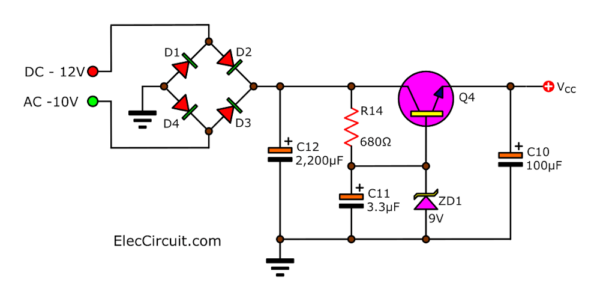
Power Supply of Preamplifier Tone control circuit
Then, a C10 helps filter with together.
Next, come to look at the adjustable tone audio section. The input signal is input to VR1, VR2 through R1, C1 to the base of Q1 by having R2-R6 to control working.
Then, the signal will be sent to the base of Q2 with R5, R7 is biased working. And the signal will through to C2 to the network circuit, the adjust base-treble by VR4, VR5.
The treble sound includes R9, C5, VR4 controls, and the bass controls include R8, C3, C4, VR3.
Then, the signal will be sent to C6 and increased up by Q3 and includes R10-R13, C7 as a low signal amplifier. The C8 is a feedback frequency offset.
Next, the signal to C9 as the output signal to the power amplifier next step.
The main feature of this tone can be adjusted high-frequency very good, the sound bright.
And nono loudness controls. The boost of bass and treble completed, so cut it out.
The designer allows for easy builds and use. We put RCA and DC jack and all potentiometers on only one PCB. We only use the RCA cable and apply small AC or DC adapter about 300-500mA to this only.
How to build it
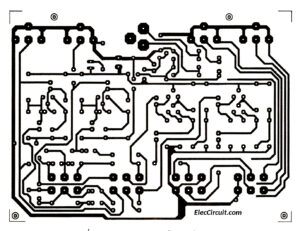
First, make the PCB as Figure 2 the PCB layout

Then assemble all parts on PCB as
Figure 3 the Component layout REAL EASY…
Parts you will need
Resistors ¼ watts +5%
- R1: 100Ω
- R2: 150K
- R3: 82K
- R4, R6_15K
- R5: 10K
- R7: 12K
- R8, R13: 5.6K
- R9: 3.3K
- R10: 8.2K
- R11: 470Ω
- R12: 47K
- R14: 680Ω
Potentiometers
- VR1_100KA Dual Audio Potentiometer
- VR2_100KMN
- VR3, VR4_100KB Dual Audio Potentiometer
Capacitors
- C1, C2, C6, C9, C11: 3.3μF 16V Electrolytic
- C3, C4: 0.03μ3F mylar
- C5_0.0047μF mylar
- C7: 47μF 16V electrolytic
- C8: 47pF 50V Ceramic
- C10: 100μF 16V Electrolytic
- C12: 2,200μF 16V Electrolytic
Semiconductor
- Q1-Q4: 2SC945
- D1-D4: 1N4001
- ZD1: 9V 0.5W
- Others PCB, jacks RCA, jack DC, adapter, etc.
Classic Low noise Pre Tone control circuit
See the image below, the preamplifier tone control circuit diagram of the home audio stereo is very well. Its low noise and sound are beautiful. Because using quality transistors.
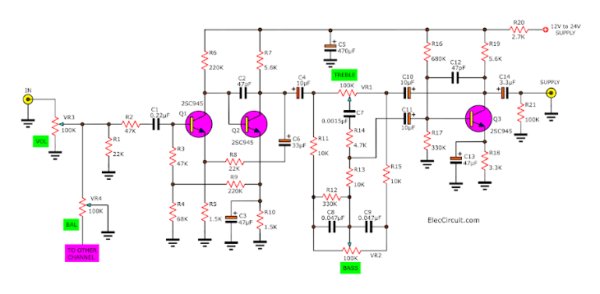
The Schematic Diagram of Mono Classic Preamplifier Tone control using 3 transistors
It has three transistors, C945 ( Equivalents of C829, C1815, or C458). They are old electronic components but useful now.
This circuit is the Mono form if you want a stereo system. You need to make 2 channels R+L.
The VR1 is 100kB for adjusting the treble tone sound. The VR2 is 100K for adjusting the bass tone audio as well.
The VR3 is 100Ka for control volume output. The VR4 is 100KW for control balance sound for other channels.
The power Supply Voltage used min 12V and min of 10mA. We hope this circuit will do you are enjoying home audio. Good luck.
How to build
You may build this project on universal PCB or Perforated PCB. Or if you want to make a PCB. See below!
The PCB layout of Classic Tone control using 3 Low noise transistors
And Here is wiring and assembly guide below.
Components list
Resistors ¼ watts +5%
- R1, R8: 22K
- R2, R3: 47K
- R4: 68K
- R5, R10: 1.5K
- R6, R9: 220K
- R7: 5.6K
- R8:22K
- R11, R13, R15: 10K
- R12, R17: 330K
- R14: 4.7K
- R18: 3.3K
- R19: 5.6K
- R20: 2.7K
- R21: 100K
Potentiometers
- VR3: 100K(A) Dual Audio Potentiometer
- VR1, VR2: 100K(B) Dual Audio Potentiometer
- VR4: 100K (MN) Bal Audio Potentiometer
Capacitors
- C1: 0.22μF Ceramic or Mylar
- C2, C12: 47pF 50V Ceramic
- C3, C13: 47μF 25V Electrolytic
- C4, C10, C11: 10μF 25V Electrolytic
- C5: 470μF 25V Electrolytic
- C6: 33μF 25V Electrolytic
- C7: 0.0015μF 50V Ceramic or Mylar
- C8,C9: 0.047μF 50V Ceramic or Mylar
- C14: 3.3μF 25V Electrolytic
Semiconductor
- Q1, Q2, Q3: 2SC945 or 2SC1815, 2SC828 NPN transistors
- Other PCB, jacks RCA, jack DC, adapter, etc.
Low noise Pre Tone control circuit
If you want a circuit that higher gain of pre-tone control circuit above. This may be your choice. See the circuit diagram.
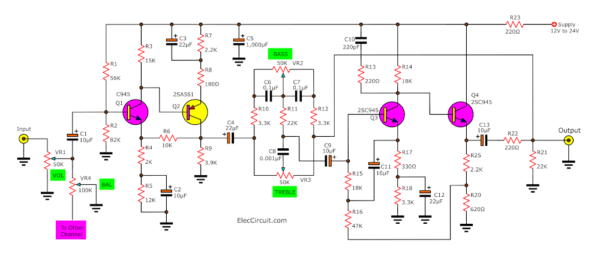
Here is 4 transistors pre-amplifier with tone control circuit diagram.
The designer change Q2 from NPN to PNP transistor and set other components to response the frequency better. At the same time it will be low noise, too.
And adding Q4 transistors makes the gain of this circuit high up. But he need to new circuit to reduce noise, too.
We love transistor circuit because can adapter any thing unlimit as idea of designer.
Also, we can adjust the bass,Treble and volume well.
This circuit is good at add treble clear and bass soft.
See in the circuit, we can use many transistors number like C945 or C828 or C1815. Which they are cheap and easy to find in any store or recycle, convenient.
The power supply should choose to be a model of DC regulator 12V to 24V at 100mA up.
Making the circuit
You may use a Perforated board PCB, which good easy.
But this circuit quite has many components. So, you need to slow in assemble it.
Some people may want to use a normal PCB. Look as below the PCB layout. And Component layout.
And see Wiring and assembly guide of this project.
Components list
Resistors ¼ watts +5%
- R1: 56K
- R2: 82K
- R3: 15K
- R4: 2K
- R5:12K
- R6:10K
- R7, R19: 2.2K
- R8, R13: 180Ω
- R9: 3.9K
- R10, R12, R18: 3.3K
- R11, R21: 22K
- R14, R15: 18K
- R16: 47K
- R17: 330Ω
- R20: 620Ω
- R13, R22, R23: 220Ω
Potentiometers
- VR1: 50K(A) Dual Audio Potentiometer
- VR2, VR3: 50K(B) Dual Audio Potentiometer
- VR4: 100K (MN) Bal Audio Potentiometer
Capacitors
- C1, C2, C9, C11: 10μF 25V Electrolytic
- C3, C4, C12, C12: 22μF 25V Electrolytic
- C5: 1000μF 25V Electrolytic
- C6, C7: 0.1μF Ceramic or Mylar
- C9: 0.001μF Ceramic or Mylar
- C10: 220pF 50V Ceramic
Semiconductor
- Q1, Q2, Q4: 2SC945 or 2SC1815, 2SC828 NPN transistors
- Q3: 2SA561 PNP transistor
- Other PCB, jacks RCA, jack DC, adapter, etc.
5 transistor Pre tone control circuit diagram
Imagine you are listening to a very beautiful song. You hear every detail of the instrument, clear voice Softly. You can stay with it all day long.
This circuit may be the best choice for you. It is a high gain of preamplifier tone control circuit using 5 transistors.
Look at the circuit diagram.
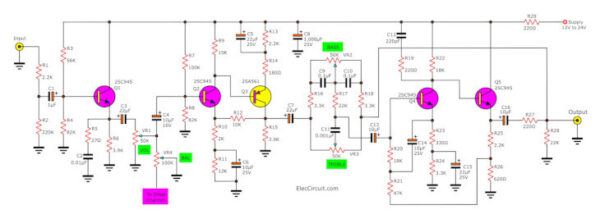
Circuit Diagram of High-quality Tone Control Mono using 5 Transistors C945
A Designer adds a preamplifier section. It consists of transistor Q1, R1-R6, C1, and C2. It gives this circuit a higher gain, can get tiny low-level audio signals of about 1mV. While still responding to sound frequencies as well and has low distortion.
Other details Still the same as the three transistors pre tone control circuit (previous circuit).
Also, See in the circuit is mono form. If you want a stereo. You need to build other one.
We can use many number of NPN transistors like C945 or C1815 or C828. The pin configuration is the same.
Making this project
I have built this project and found that the strength and sound quality are good when compared with IC op-amp circuits.
But to build this project requires high neat. Because it uses a lot of components.
Also, you can use perforated PCB. Or make a normal PCB.
Then assemble all parts on PCB as layout below.
And see the Wiring and assembly guide of this project.
Download This
All full-size images of this post are in this Ebook: Elec Circuit vol. 2 below. Please support me. 🙂
Components list
Resistors ¼ watts +5%
- R1, R13, R25: 2.2K
- R2: 220K
- R3: 56K
- R4, R8: 82K
- R5: 27Ω
- R6: 3.9K
- R7: 100K
- R9: 15K
- R10: 2K
- R11: 12K
- R12: 10K
- R14: 180Ω
- R15: 3.9K
- R16, R18, R24: 3.3K
- R17, R28: 22K
- R19, R27, R29: 220Ω
- R20, R22: 18K
- R21: 47K
- R23: 330Ω
- R26: 620Ω
Potentiometers
- VR1: 50K(A) Dual Audio Potentiometer
- VR2, VR3: 50K(B) Dual Audio Potentiometer
- VR4: 100K (MN) Bal Audio Potentiometer
Capacitors
- C1: 1μF 50V Electrolytic
- C2: 0.01μF Ceramic or Mylar
- C3, C5, C7, C15: 22μF 25V Electrolytic
- C4, C6, C13, C14, C16: 10μF 25V Electrolytic
- C8: 1000μF 25V Electrolytic
- C9, C10: 0.1μF 50V Ceramic or Mylar
- C11: 0.001μF 50V Ceramic or Mylar
- C12: 220pF 50V Ceramic
Semiconductor
- Q1, Q2, Q4, Q5: 2SC945 or 2SC1815, 2SC828 NPN transistors, or better read below.
- Q3: 2SA561 PNP transistor or better read below.
- Other PCB, jacks RCA, jack DC, adapter, etc.
Alternate Of C945 and A561 Transistor
If you cannot find the transistors. You can use alternate transistors. But Its pin configuration is different see in the diagram below before replacing in the circuits.
C945: 2N3904, BC547
A561: 2N3906, BC557
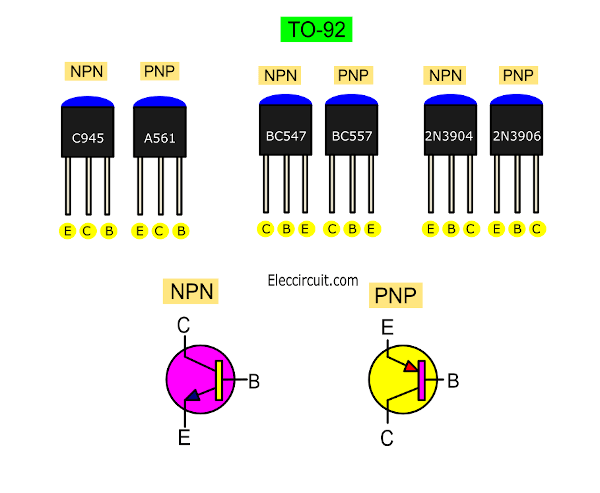
Its performance is similar. May be higher as well Because it has more collector current (IC) and higher frequency response.
18V Regulator circuit
These classic pre-tone control circuits (Circuit 1, 2, 5, 6, and 7) require a 12V to 24V DC power supply. Since they use low current. But it should be a DC regulator circuit only. I recommended this circuit below.
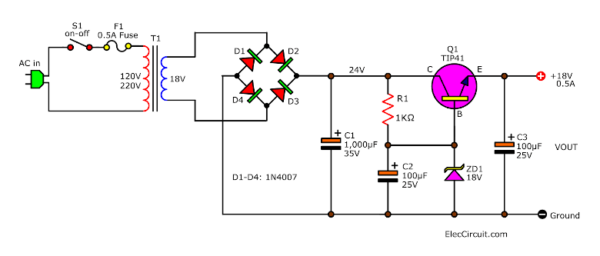
It is a series voltage regulator using Zener and transistor. So easy and cheap. However, they are enough for our pre-tone control circuits.
Here is PCB layout and components layout.
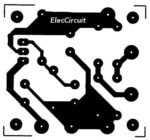
PCB layout 18V regulator
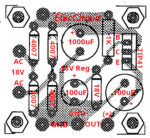
Components layout of 18V regulator
Check out these tone control circuits
You can also view these circuits. They are better quality.
High quality tone control circuit diagram – Uses Low noise transistors and is a Pre-amplifier circuit with higher gain. Improved circuit layout.
5 (bass mid treble) Tone control projects using 4558 NE5532 – Easier to create and higher sound gain or sensitivity. Therefore, it is more popular than general transistor circuits.
GET UPDATE VIA EMAIL
I always try to make Electronics Learning Easy.
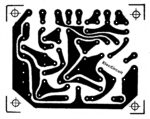
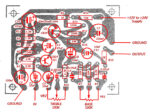
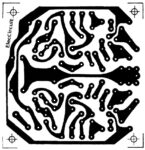
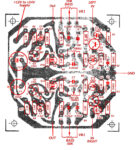
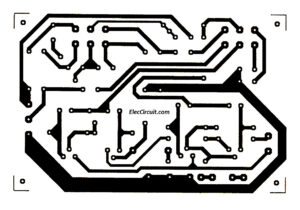
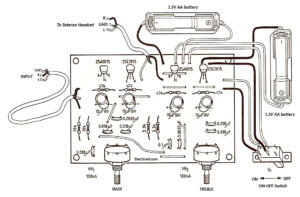
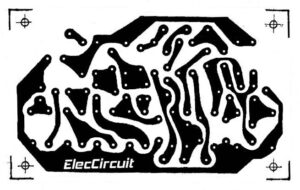
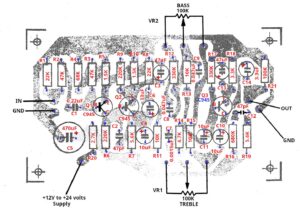
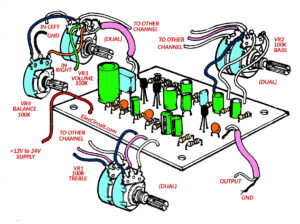

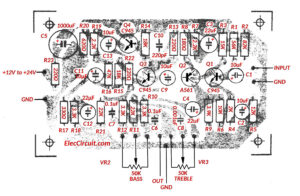
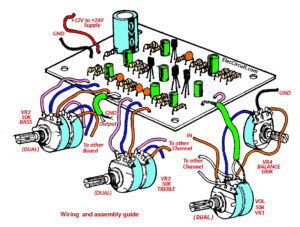
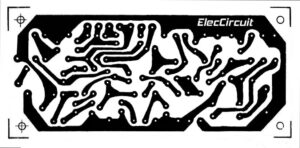
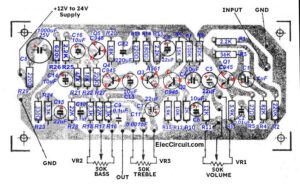
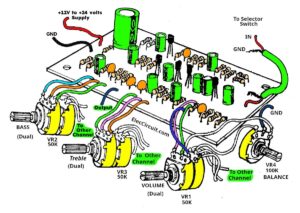
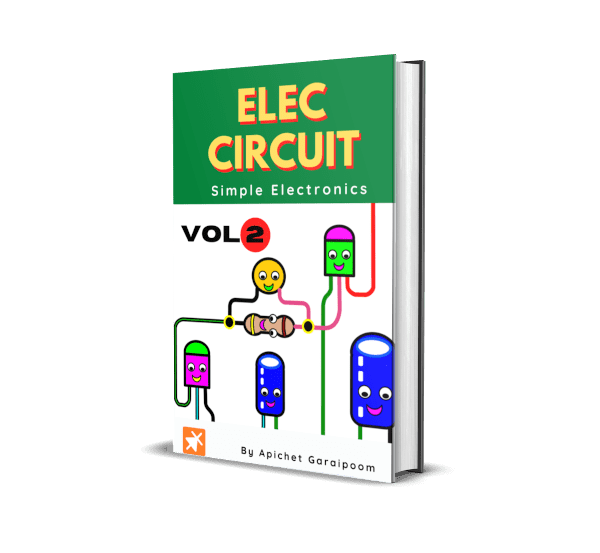
It worked great but the treble could not be heard clearly.
dear students plz c this circuits and dnt mis use this circuit
hi l am benjamin form ghana i lake to do eletronic bat i need a help whit componet. ido not have maney to bye so pelese help me
mine is not working…. all the components are complete but there is no sound…. let me check admin transistors are c945 which is npn in the a561 pnp?? i dont know where i wrong.. this is my 3rd time building ma own circuit… this is only not working.. can i ask u mensah can u sent me ur photo on this circuit.. please… ty
really want a 5 transistor amp –using Only available BC 547/557 TRANSISTORS—
CAN U CREATE SUCH A CIRCUIT ?
NONE OF YOUR RARE ODD TRANSISTORS CAN BE FOUND!
IS IT POSSIBLE?—-WHAT WATTAGE OUTPUT WILL I GET?
BC 547——BUILD A CIRCUIT 4 ME—-5 TRANSISTORS
THANKS —-CARL WINTER
Build it yourself…
I like how concise your notes are. It is one of greatest dreams to build an audio amplifier myself but unfortunately , I the basic knowledge about ;
Its work fine , I used 4 x 2N3904 and
1 x 2N3906 for TR-3
Thanks
y mine s not workng…fdbak some trobleshotng plz…i used cap 10uf/16v @ ur layout 10uf/10v…s dat ok??..
Do you have any video of that? I’d want to find out some additionaal information.
It always seems to work much better if you use a separate Input amplifier, conected to a Tone control [baxandall] circuit, which is in turn connected to a output stage which feeds the main amplifier. You do not need high power amplifiers for home use, Ten Watts [x2] of stereo sound is plenty and also cheaper to run. The more power you use the easier it is to generate more distortion. A distortion figure of up to .1% is very acceptable. I have used this system for many years with trouble free operation. My frequency response is 10HZ to 50KHZ. Your speakers play an important part in the final sound reproduction and must be capable of reproducing 10HZ to 50KHZ. The better your speakers are the better quality of sound you will hear. HL.
thanks ..
hey, great, can i use this 7 number pcb in my 200 watt rms power subwoofer??
So awesome frequency response and fidelity. I adopt this setup to hi fi PA sound enhancement tecnique with stereo studio master PA amp. Thanks.
thanks..
you are great person in a world, because you are sharing best knowledge for others
I have made the 8th one type and it works perfectly, without any noise.
Hello Atlee,
Oh…Thanks for your feedback. I am happy to hear that.
Have a great day.
Thanks
Apichet
Hi! I built it, and it is working perfectly, but I don’t know that which Power amp. would be suitable for it. I’d like to ask anyone who built a poweramp (transistor or opamp) to help me with a schematic.
Thanks a lot!
Sorry, i have missed the number at my former post. I was talking about #8 circuit. Thanks.
Hello Kovács Attila,
Thanks a lot. I am so happy that you like that circuit. It is a great pre-tone preamplifier, I love it, too.
You may may this amplifiers:
https://www.eleccircuit.com/40w-amp-ocl-2n3055mj2955/
https://www.eleccircuit.com/the-cheap-100-watt-transistor-power-amplifier-project/
They use all transistors. I love transistor circuits. It is a clear sound and soft and smooth…
I hope you are happy with a great audio system in your home.
Have a great day.
Thanks a lot. May I have a question? Do you know a transistor based power amplifier which i can attach after this preamp?
I would need about 5-7 W max, with single type supply is available.
Thanks.
Hi Kovács Attila,
Do you want transistor circuits?
If you want any circuits. I think using TDA2030 is good. https://www.eleccircuit.com/tda2030-audio-amplifier-circuits/
For transistor circuit 10 watts. I have a circuit but I am drawing it. Please wait for me.
Thanks a lot.
Hi!
I’d be very happy if you could draw me one. I have attached a dozen of them so far, but all of them were “incompatible” with #8, with a large distorzion.
Thanks.
Hello!
Thanks for your help! I think this 40W Tr. amplifier “https://www.eleccircuit.com/40w-amp-ocl-2n3055mj2955/” could be attached after #8 tone control. In near future i will make it, and inform you if it works togedher with preamp.
Have nice day!
Hi friend,
It is great. You can do it. I believe.
Have a nice day too.
Ref#2.Stereo Tone Control Using 2 Transistors C945
1.I notice the input ac coupling capacitor C1 polarity orientation with reference to base of Q1 is different in Component Layout when compared with the respective schematic diagram.
2.In Schematic Diagram,-ve terminal of C1 is connected to base of Q1 while in Component Layout +ve terminal of C1 is connected to base of Q1.
3.Please can you verify which one is correct.
Hello Gobi,
Thanks for your visit. The positive of C1 will be connected to B of Q1.
Have a nice day.
Thank you so much for these awesome circuits. I’ve successfully built 2 × 5 transistor pre amps and sound quality is better than other op amp ICs I’ve tried. I used BC547 and BC557.
I and my dad congratulate you that can create that circuit successfully.
I thought of myself who had previously failed to build a circuit, but when I did, I felt so happy.
In the future I might build this circuit even though I don’t like audio circuits at all.
My grandma doesn’t like us playing loud music or doing anything loud with the stereo. 🙂
That is funny and lovely. Maybe she is concerned about your ear health. I wish your family health and wealth.
Thank you so much again. 🙂
Hi,
The pleasure was mine. We wish your family health and wealth as well. 🙂